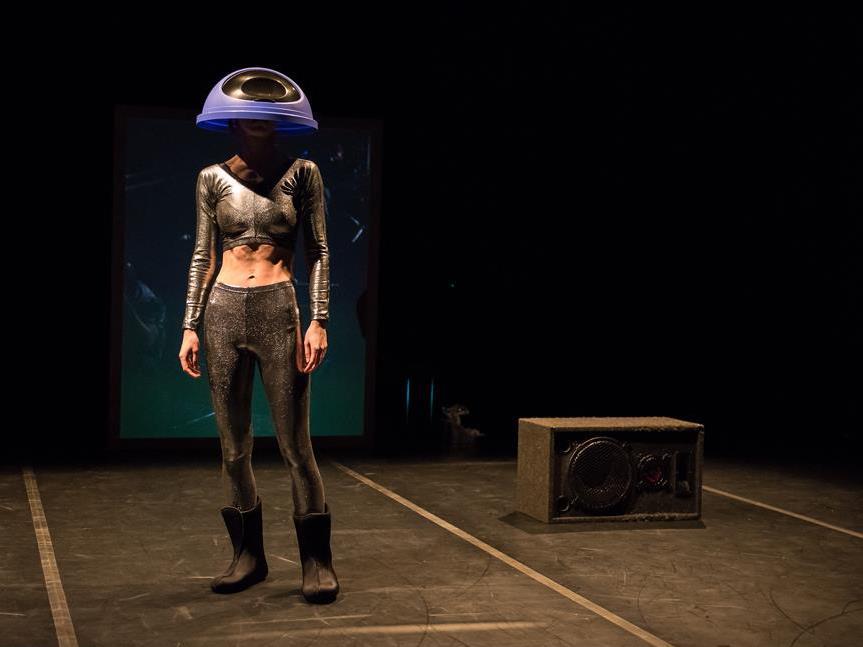Image: Gregory Lorenzutti
Body Of Work took as its subject the foundation and shared ground for all performance – presentness, nowness and contemporaneity. In doing so Eke placed her own body as the center point and generated a plethora of performing bodies: old, new, transformed and other. She multiplied her own image and presence through digital capture, each time shifting the body so we begin to see difference, creating layers of her body, that body, other body, seen body, performing body and captured body. She created visibility of the theatrical space and its devices to further deviate from the conventions of (present, live, real) performance.
Eke created a kind of ‘temporal saturation’, as Jenn Joy termed in her book The Choreographic, by simultaneously presenting bodies from different moments in time. The digital capture formed a graphic-like representation of duration, as documented moments were layered upon one another, each new image moving the previous further back on the screen, away from the audience. Body of Work created ‘a system of representation of a physical world where future, present, and past become interlined figures of underexposure [mystery], exposure [reality], and overexposure [fiction]’ said Paul Virilio in Polar InertiaFor me, Body of Work re-choreographed our perception time. Eke placed herself, and us, in the center of time’s passage, no longer moving forward into the future, but remaining present and watching the past move away. The movement of time was in the decline of the present moment, rather than the arrival of the future.
Within this process of temporal layering, Eke interacted with the captured bodies, creating a slippery subject/object relationship between her body and the imagery. The attention (and function) of Eke’s live body shifted toward the creation of the digital images throughout the work. As a result, the performance divides (or multiplies) and two parallel performances emerge: the digital and the physical. (This distinction is somewhat clumsy and crude, but in making it I am attempting to locate my experience of the work in between.) In one layer we see the digital images as the subject, and the physical body as a function to enable their presentation. In the other layer we understand Eke’s physical body and her actions of creation as the subject of the performance and the images become an other body or a scene-like replication. Eke’s sharp performative presence prevents her physical body from quietly slipping underneath the magnificence of the digital imagery.
In navigating my way thorough these layers I found myself continually realigning with the present action, and continually detaching from the digital image. I felt my gaze contract and expand, reframing the performance – maybe I somewhat embodied the camera? The pace of the work left no time to linger, prompting a dynamic spectatorship. As Miguel Gutierrez describes ‘[There is] no such thing as transitions: this exists and then this exists’ providing no space between present and past – just now becoming then – and my continual realignment to that change.
The theatre also held particular power in crafting the imagery. Eke utilised theatrical devices to dramatise the body. We see the body and the theatrical space transform with the application of costumes, props, sound and lighting. Eke makes these devices visible without diminishing their effect. She sips blue liquid from a cup in the background and positions herself before the camera to capture a close up of her face, staring into the lens, the blue liquid escaping from her mouth. We see the mechanics involved in creating this moment, yet its haunting visual effect persists. There is something quite cinematic about it too, the magic of the screens, the enlarging of the image. Body of Work allows fiction and character to enter its terrain, becoming another device, creating another body. Through these theatrical devices our association of real and fiction begins to oscillate.
It was a remarkable experience; the theatre; Eke’s body and time transformed and coalesced, creating a landscape of performing, actioning and reproduced bodies. Physicality, images, realities and fictions diverging, converging and emerging in parallel times. And the sound score was beyond incredible!
Body of Work, Atlanta Eke
Dance Massive
16 March 2015





